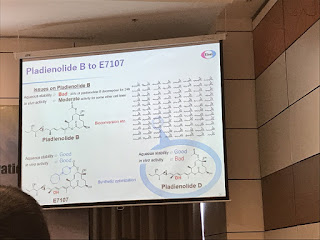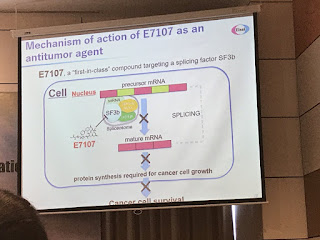Thailand Lab 2017: Challenges in Natural Product and Drug Discovery
Challenges in Natural Product and Drug Discovery
----
Dr. Kappei - Eisai company, Japan
Attractiveness of the resource
26% of fda approve is derived from the natural products
The drugs that received from the np (natural product) - require more chemical rxn synthesis.
This company can find the resource for making the drug synthesis through the collaboration, he mentioned the Asia is under explored and he would like to look for the opportunity.
It sounds to me that this company has good resource in the chemoinformatics regard to the natural products.
Halichondrin b to erinbulin example of success,
The halichondrin is extracted from the marine organism but the resource is very limited, therefore requiring more of chemical synthesis to help.
This another example of the process for the drug discovery, Pladienolide B to E70107 -
The original compound requires more modification in order to make it more stable and more solubility.
Not only the chemical process, using the biological organism to bioconvert the parental strand to the targeted product can be applied to the drug discovery.
Here is the action of this chemical compound.
He is looking for our resources!!!! - sounds to me, it is very important to have np informatics to collect all the data receive from the np extracts.
Marine product is really hard to culture. Sound like, it can be the main obstacle too.
----
Dr. Wanchai introduced the meeting that they want to launch the np extract database - chemical library of Thailand.
He mentioned our situation in Thailand where basically we focus on the biodiversity but not much on the chemodiversity from our own resources.
Here is the example that his group collaborate with researchers in Japan group and can extract and identify the compound as the database - which can later be used the qsar modeling to screen the potential compounds that might have the biological effect.
This is the group of biodiversity which has been launched for a while and also the group that makes the biodiversity resources more organize.
He showed that the np field is largely done in later year, he also mentioned the thai university that contributing to this extraction - he showed the compounds that has been discovered by Thailand research group -
Not only the pure compounds that he focuses, he also mentioned on the herbal crude extract since Thailand has used them for a long time ago.


Now he also categorizes the sources that he could get the resources.


He sorts to organize the np extracts and tries to make the most benefit out of it.
He mentioned on the trend of np extracts combining with genomics era which he would like to make use out of it. He compares the technology between Thailand and the other countries where they have the chemoinformatics from the np extract.
Now, he is updating the current situation that has been supported by nrct which is the major funding for the drug discovery from the natural resources.
One of the audience raised the issues that we have compounds which getting the stuck at the applications which mean it could not be out for the market.
---
After talking with the participants as well as looking at the presentation, realized that it would be better to run the lc-ms first from the crude extract, to get rid of the compounds that have been already well characterized. Besides, if the unique compounds are found then in sillico docking will save cost for biological screening. However, there is the debating about we could miss the biological hit compound since in sillico is just the prediction. Another suggestion for in sillico issue is that the factors that put in the program, like the protonated or microenvironment, flexibility of the structure, also help us the get the potential hit compound when being biological tested.


























Comments
Post a Comment